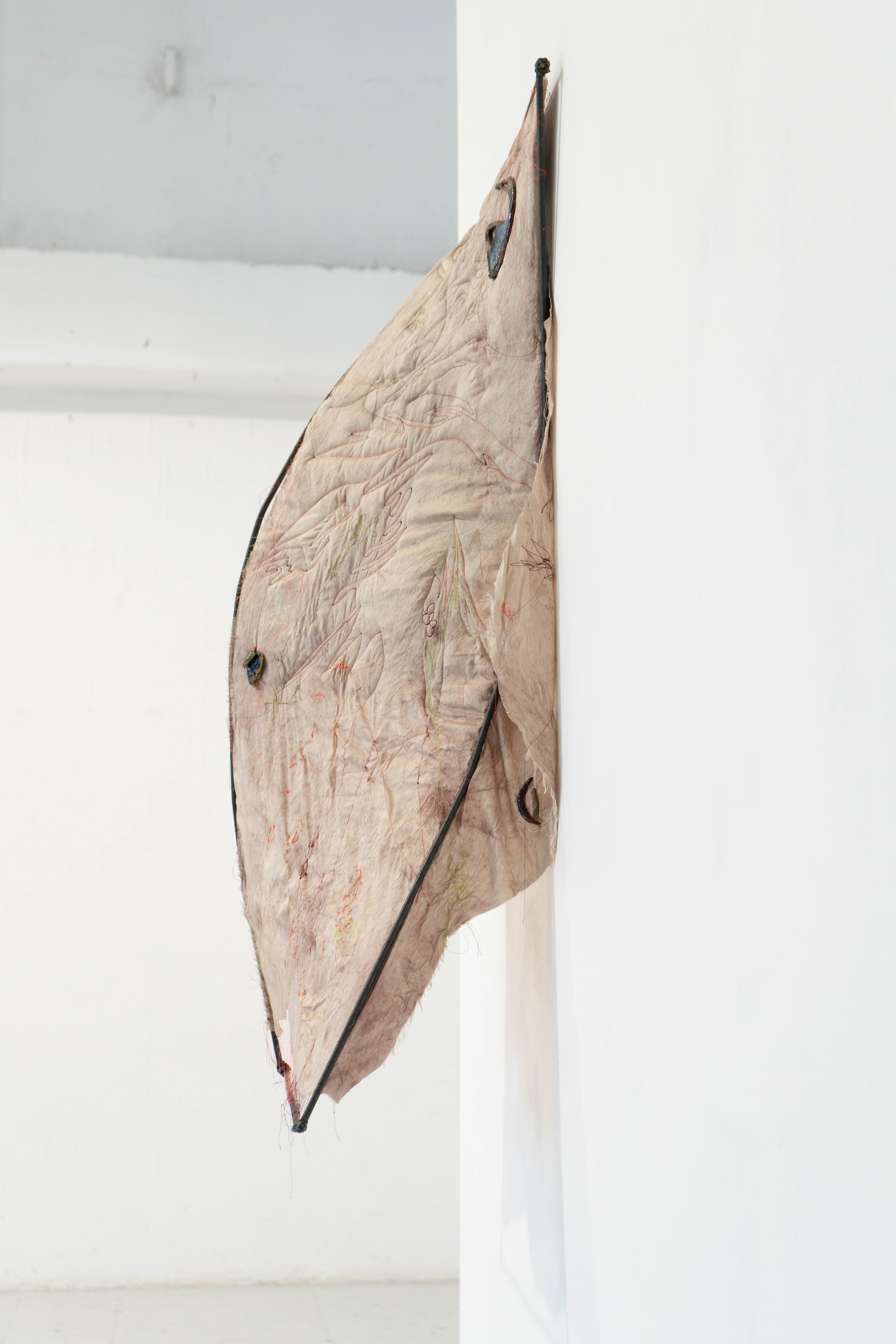in the tainted water my armor shattered, 2024
created at PADA Artist Residency in Barreiro, Portugal
Exhibitions:
Limburg Biënnale, Marres, Maastricht upcoming! 29-06/25-08: link
PADA studios, 2024, Barreiro, Portugal
While researching the history of diving and diving suits from a residency in Barreiro, Portugal. I was drawn to the many different structures, surfaces and materialities of industrial waste located in close proximity to the residency. Much of the waste had been there for years, seemingly contained. But some of the factories are still running, and the contamination continues still today. Visible, in the shape of thick, tainted and smelly streams flowing into the Tagus estuary. Invisible, among others through the extra land that was built in the Tagus River with the use of industrial waste to make the industrial area bigger. Hence the sediment is also deeply contaminated:
“The current study was carried out in the Tagus estuary, located in the Lisbon metropolitan area, which is the most populated
area of Portugal (2.7 million people). This estuary, one of the largest in Europe (320 km2 of area), has an extremely high socio-economic importance, since it supports numerous industries and a high population density. Tagus estuary has a historic and intensive anthropogenic pressure, due to urban effluents from about 3 million inhabitants, together with contamination resultant from diverse chemical, petrochemical, metallurgic, shipbuilding, cement manufacture industriesand agriculture fertilizers/pesticides (Duarte et al., 2008). These pressures led to a high accumulation of trace elements in sediments and organisms, particularly in the Barreiro area” (Patricia Pereira, 2013).
created at PADA Artist Residency in Barreiro, Portugal
Exhibitions:
Limburg Biënnale, Marres, Maastricht upcoming! 29-06/25-08: link
PADA studios, 2024, Barreiro, Portugal
While researching the history of diving and diving suits from a residency in Barreiro, Portugal. I was drawn to the many different structures, surfaces and materialities of industrial waste located in close proximity to the residency. Much of the waste had been there for years, seemingly contained. But some of the factories are still running, and the contamination continues still today. Visible, in the shape of thick, tainted and smelly streams flowing into the Tagus estuary. Invisible, among others through the extra land that was built in the Tagus River with the use of industrial waste to make the industrial area bigger. Hence the sediment is also deeply contaminated:
“The current study was carried out in the Tagus estuary, located in the Lisbon metropolitan area, which is the most populated
area of Portugal (2.7 million people). This estuary, one of the largest in Europe (320 km2 of area), has an extremely high socio-economic importance, since it supports numerous industries and a high population density. Tagus estuary has a historic and intensive anthropogenic pressure, due to urban effluents from about 3 million inhabitants, together with contamination resultant from diverse chemical, petrochemical, metallurgic, shipbuilding, cement manufacture industriesand agriculture fertilizers/pesticides (Duarte et al., 2008). These pressures led to a high accumulation of trace elements in sediments and organisms, particularly in the Barreiro area” (Patricia Pereira, 2013).
Local biologists have been looking into the eyes of a specific fish specie in Barreiro, and they reveal high levels of metal-contamination. The fish eye has a wide surface area that is continuously in direct contact with the external medium, thus this neurosensory organ can be a relevant uptake route for metals. The eye lens, in particular, has a unique morphology, offering a historical record of exposure to metals throughout their lifetime.
This made me reflect on the diving suit in a broader perspective; as a delusion of purity and protection in the form of a protective skin. Metals are now contained in these bodies of water, into the bodies of fish, and in turn in human bodies.
1) The copper piece of this series resembles a fragile, shattered yet sharp diving armor, with imprints that refer to the natural aquatic environments it has entered. The shapes resemble gills, scales, and the shape of an eye: blurring the boundaries of whose skin, armor or eye we are actually looking at.
2) The textile piece of this series is dyed in pyrite-contaminated waters at the industrial site in Barreiro. Through stitches and clay aquatic organisms such as plants and scales are resembled, as well as nerves and veins (which play a role in distributing metals). The contaminated fabric leaks out of its twisted frame, referring to the fiction of “contained” contamination and thus the fiction of the separation between nature and human.
3) The bronze piece of this series questions this idea of a separation between the body and its environment, and suggests the mutated body being aquatic.
This made me reflect on the diving suit in a broader perspective; as a delusion of purity and protection in the form of a protective skin. Metals are now contained in these bodies of water, into the bodies of fish, and in turn in human bodies.
1) The copper piece of this series resembles a fragile, shattered yet sharp diving armor, with imprints that refer to the natural aquatic environments it has entered. The shapes resemble gills, scales, and the shape of an eye: blurring the boundaries of whose skin, armor or eye we are actually looking at.
2) The textile piece of this series is dyed in pyrite-contaminated waters at the industrial site in Barreiro. Through stitches and clay aquatic organisms such as plants and scales are resembled, as well as nerves and veins (which play a role in distributing metals). The contaminated fabric leaks out of its twisted frame, referring to the fiction of “contained” contamination and thus the fiction of the separation between nature and human.
3) The bronze piece of this series questions this idea of a separation between the body and its environment, and suggests the mutated body being aquatic.




